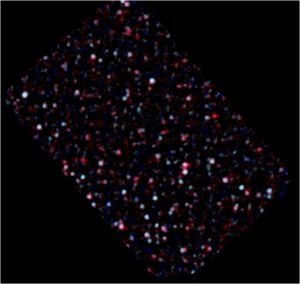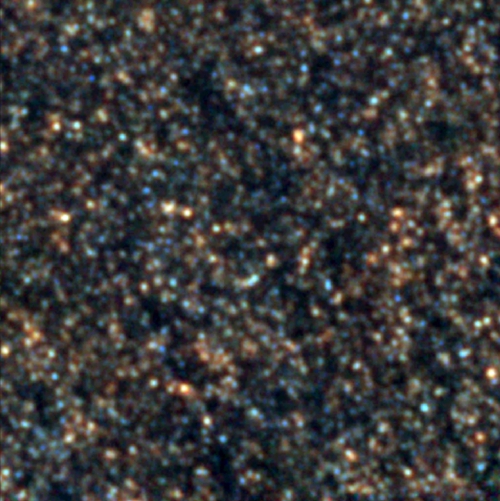| Basic Information | |
| What is this? | A view of thousands of distant galaxies, in a patch of sky called GOODS-North |
| Where is it in the sky? | In the constellation of Ursa Major, the Great Bear |
| How big is it? | The image is half a degree across – about the size of the Full Moon |
| How far away is it? | The galaxies are at different distances, seen as they were 3-10 billion years ago |
| What do the colours represent? | Red galaxies are either cooler or more distant, while blue galaxies are either warmer or closer to us |
Downloads
See this object in:
This image shows an area of sky called the “Great Observatory Origins Deep Survey” (GOODS), which has been observed by many telescopes at a range of wavelengths, and now by SPIRE in the far-infrared. It is an area of sky devoid of foreground objects, such as stars within our Galaxy, or any other nearby galaxies, and is a little larger than the area of the full moon as observed from Earth. The image is made from the three SPIRE bands, with red, green and blue corresponding to 500 micrometres, 350 micrometres and 250 micrometres respectively.
Every fuzzy blob in this image is a very distant galaxy, each one so far away, that the light has taken billions of years to travel across the Universe. They are seen as they were 3—10 billion years ago when the star formation was very widely spread throughout the Universe. Professor Seb Oliver, said “Seeing such stunning images after just 14 hours of observations gives us high expectations for the full length observations over much larger regions of the Universe. This will give us a much clearer idea of how star formation has progressed throughout the history of the Universe”. The redder objects are either more distant, as the expansion of the Universe has stretched, the light more since it was emitted by the galaxy, or much cooler than the bluer galaxies. This is the first time much of the Cosmic Infrared Background, discovered in the 1990s, has been resolved into the individual galaxies. Studying these galaxies at this early stage of the Universe will allow astronomers to test their models of star and galaxy formation.

Herschel’s other imaging camera, PACS, has also been imaging this region of sky, as shown on the right. The PACS instrument observes at shorter wavelengths than SPIRE, between 70 to 160 microns. This gives it better resolution, though the sensitivity to these distant objects is not quite as good. In the image on the right, red corresponds to a wavelength of 160 microns and blue to 70 microns.
The region of sky has been observed by many different telescopes at a range of wavelengths, but normally over a much smaller area of sky. The first such telescope was the Hubble Space Telescope, observing what has become famously known as the “Hubble Deep Field” over the course of 10 days. The same region of sky was also observed by the SCUBA instrument on the James Clerk Maxwell Telescope, at a wavelength of 850 microns (shown below). While the SCUBA image took 20 nights and identified just five galaxies, this SPIRE image took just 14 hours and has identified thousands.
The Herschel SPIRE image was taken as part of the Herschel Multi-tiered Extragalactic Survey (HerMES) key programme of Herschel, which will observe over 70 square degrees of sky, aiming to trace how the rate of star formation has changed over the history of the Universe.
Detailed Information
HerMES

